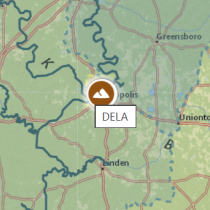NEON and LTER: Two complementary networks for ecological research
November 18, 2011
The Long-term Ecological Research Network (LTER) and NEON are highly complementary networks that support ecological research in different ways, but are becoming more and more integrated over time. NEON is a continental-scale infrastructure facility providing physical and data resources to researchers and educators. LTER is a network of long-term research projects aimed at understanding processes in a wide range of ecosystems. While the NEON observatory sites were selected to cover U.S. ecological variability according to defined criteria, LTER sites are selected on a site-by-site basis chosen based on the intellectual importance and insight of the questions proposed for that site. LTER has consensus network core research areas (e.g., understanding patterns and controls of net primary production) but site- and PI-specific research approaches are used to carry out common research goals. LTER research is primarily site-based to regional, whereas NEON addresses a narrower set of questions at regional to continental scales using common infrastructure and protocols across sites. NEON and LTER have worked together closely in many ways:
- Many LTER scientists participated in NEON’s early planning and brought insights into issues they wanted to study, but could not within the structure of LTER.
- Many NEON sites are co-located with LTER sites and complement the existing LTER infrastructure.
- LTER and NEON are collaborating on the development of ecological informatics and members from each network serve on each other’s working groups and planning teams.
- NEON has designed an urban observing network addressing issues and questions largely arising from work done in the Urban LTER sites, but adding a standardized set of long-term instrumental and biological measurements to enable comparative studies between cities and across urban to rural gradients.
| LTER - NEON Site Correspondence (draft list of sites) |
||
| LTER Site | Type of NEON Site | NEON Domain |
| Harvard Forest | Core site Core aquatic site |
1 – Northeast |
| Plum Island Ecosystems | Urban relocatable | 1 – Northeast |
| Baltimore Ecosystem Study | Invasives relocatable site Core aquatic site |
2 – Mid Atlantic |
| North Temperate Lakes | Core site Core aquatic site |
5 – Great Lakes |
| Konza Prairie Biological Station | Core site | 6 – Prairie Peninsula |
| Central Plains Experimental Range | Core site | 10 – Central Plains |
| Niwot Ridge | Core site Core aquatic site |
13 – Southern Rockies & Colorado Plateau |
| Central Arizona Phoenix | Urban relocatable | 14 – Desert Southwest |
| Jornada Basin | Climate relocatable | 14 – Desert Southwest |
| HJ Andrews Experimental Forest | Core aquatic | 16 – Pacific Northwest |
| Toolik Field Station (Arctic) | Core site Core aquatic site |
18 – Tundra |
| Bonanza Creek | Core site Core aquatic site |
19 – Taiga |
Now that NEON is entering the construction phase, there are many other ways in which the LTER science community and the NEON facility can interact in the future. The close involvement of LTER scientists in NEON’s technical working groups will infuse many of the lessons learned from LTER into NEON’s implementation, while at the same time giving LTER scientists insight into NEON’s scientific, education, and public engagement capabilities. Both programs provide critical infrastructure to researchers in NSF’s new Macrosystems Biology program, and the observations, facilities and informatics from the two programs will power a new generation of exciting work by the broader research community. As the NEON taskable facilities come on line, such as the Airborne Observation Platform, these capabilities will be available for use by LTER and non-LTER scientists alike. Going forward, the two programs will plan joint research, education, and informatics workshops, intensified involvement in each other’s organizational committees, and scientific working groups. This will lead to further synergistic integration and increased collaboration between these two large-scale, long-term networks.
Story co-written by Scott L. Collins (Chair, LTER Executive Board and Science Council), Dave Schimel (NEON Chief Science Officer) and Brian Wee (NEON Chief of External Affairs).
